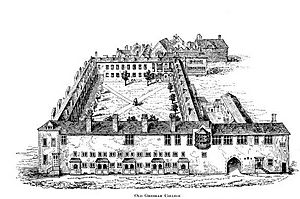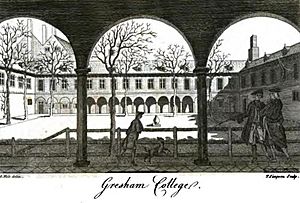Gresham College and the formation of the Royal Society facts for kids
The Gresham College group was a collection of scientists in England during the 1640s and 1650s. Think of them as an early science club! This group was very important because it helped create the Royal Society of London, which is one of the oldest and most famous science organizations in the world.
People have debated for a long time about exactly how the Royal Society started. But most agree that the Gresham College group played a key role.
Gresham College in London was a special place. It wasn't like the old universities. Instead, it offered lectures to the public. This made it a perfect spot for smart people, called "virtuosi" or "natural philosophers" (which meant scientists back then), to meet and share ideas.
There were actually a few different groups that met in London and Oxford during the English Civil War (1642-1651) and the time after it. Two of these groups were based at Gresham College:
- The 1645 group, who were interested in doing science experiments.
- The 1660 committee of 12, who helped officially form the Royal Society between October 1660 and 1662.
Historians agree that the science network at Gresham College was crucial for the meetings that led to the Royal Society's creation.
Contents
The 1645 Gresham College Group
The "1645 group" started meeting around 1645. They might have met at Jonathan Goddard's home in Wood Street or Cheapside before or at the same time as their Gresham College gatherings. Some accounts say Theodore Haak helped bring this group together.
Important members included John Wallis, George Ent, Francis Glisson, Charles Scarborough, John Wilkins, Samuel Foster, and Christopher Merret. This early group stopped meeting around 1648.
Historians have looked closely at old writings to understand this group. For example, John Wallis wrote two accounts about these early meetings. One was in 1678 and another in 1697. These writings helped later historians like Thomas Birch understand how the Royal Society began.
However, some people question if Haak's role was as central as Wallis suggested. Haak was also connected to other important thinkers like Marin Mersenne and the Hartlib Circle.
How the Group Connected with Others
For a long time, people thought the 1645 Gresham group was the same as the "invisible college." This "invisible college" was mentioned in letters by the young scientist Robert Boyle in 1646 and 1647.
Today, most historians don't think they were the same. Other groups are now seen as more likely candidates for Boyle's "invisible college." These include parts of the Hartlib Circle and a group led by Lady Ranelagh, who was Boyle's sister.
Only one person from the "invisible college" (as described by Boyle) played a big part later in the Royal Society: William Petty.
After the first English Civil War, John Wilkins and John Wallis moved to Oxford in 1648. There, Wilkins started a new group, sometimes called the Oxford Experimental Philosophy Club. This group brought together scientists from different backgrounds. Many key figures for the future Royal Society joined this Oxford group.
Later, some of these scientists moved back to London and Gresham College as jobs became available.
Gresham College Professors (1650–1660)
Gresham College had seven teaching positions, called professorships. These were in subjects like Astronomy, Divinity (religion), Geometry (math), Law, Music, Physic (medicine), and Rhetoric (public speaking).
Many of the professors at Gresham College during the 1650s became important members of the Royal Society. Here's a look at who held these positions:
| Year | Astronomy | Divinity | Geometry | Law | Music | Physic | Rhetoric |
|---|---|---|---|---|---|---|---|
| 1650 | Samuel Foster | Thomas Horton | Daniel Whistler | John Bond | William Petty | Thomas Winston | John Goodridge |
| 1651 | Foster | Horton | Whistler | Bond | Petty | Winston | Goodridge |
| 1652 | Lawrence Rooke | Horton | Whistler | Bond | Petty | Winston | Goodridge |
| 1653 | Rooke | Horton | Whistler | Bond | Petty | Winston | Goodridge |
| 1654 | Rooke | Horton | Whistler | Bond | Petty | Winston | Richard Hunt |
| 1655 | Rooke | Horton | Whistler | Bond | Petty | Jonathan Goddard | Hunt |
| 1656 | Rooke | Horton | Whistler | Bond | Petty | Goddard | Hunt |
| 1657 | Christopher Wren | Horton | Rooke | Bond | Petty | Goddard | Hunt |
| 1658 | Wren | Horton | Rooke | Bond | Petty | Goddard | Hunt |
| 1659 | Wren | Horton | Rooke | Bond | Petty | Goddard | William Croone |
| 1660 | Walter Pope | Horton | Rooke | Bond | Thomas Baines | Goddard | Croone |
By 1659, five of the seven professors were people who would become very important in the Royal Society. These included Christopher Wren (Astronomy), Lawrence Rooke (Mathematics), William Petty (Music), Jonathan Goddard (Physic), and William Croone (Rhetoric).
Some historical accounts mention an "Oxonian Society" (a group from Oxford) that met at Gresham College starting in 1659. These meetings happened twice a week. However, the college was used by soldiers in 1659, which stopped the meetings for a while. After King Charles II returned to power in 1660, the meetings started again and became even bigger.
The 1660 Gresham College Group
On November 28, 1660, a very important meeting took place at Gresham College. It happened in the rooms of Lawrence Rooke, right after a lecture by Christopher Wren. During this meeting, they wrote down a plan for a new "college" or society.
This committee is seen as the main force behind the founding of the Royal Society. It was how a group of smart, curious people turned their informal meetings into a formal, respected learned society.
Here were the members of this key committee:
| Member | Background | Future role |
|---|---|---|
| William Ball | A lawyer and astronomer who joined the meetings at Gresham College in 1659. | |
| Robert Boyle | An important scientist known for his experiments. He was connected to other science groups in the 1640s and 1650s. | |
| William Brouncker | A mathematician and an Irish nobleman. | First President of the Royal Society (PRS). |
| Alexander Bruce | A Scottish inventor. | |
| Jonathan Goddard | A physician. | |
| Abraham Hill | A wealthy London merchant who had rooms at Gresham College. | |
| Sir Robert Moray | A Scottish nobleman who had been in exile. | |
| Paul Neile | An astronomer. | |
| William Petty | A statistician and economist. | |
| Lawrence Rooke | A mathematician. | |
| John Wilkins | A natural philosopher (scientist). | |
| Christopher Wren | An experimental scientist and famous architect. |
Some members, like Brouncker, Moray, Bruce, and Neile, had connections to the royal court. William Croone was not there but was nominated for a committee position.
After this meeting, the group became known as the "Philosophical Society." They started inviting more members in 1661, like William Erskine.
The Royal Society officially received its name and special rights through three royal documents, called royal charters, in 1662, 1663, and 1669. The "founding Fellows of the Royal Society" are considered to be those who were members by June 1663.
The Royal Society at Gresham College
Once it was officially formed, the Royal Society continued to meet at Gresham College. They stayed there until the terrible Great Fire of London in 1666. After the fire, they had to move to Arundel House.
The Society was given the land of the old Chelsea College, but they never really used it. They eventually sold it in the 1670s.
Images for kids
See also





